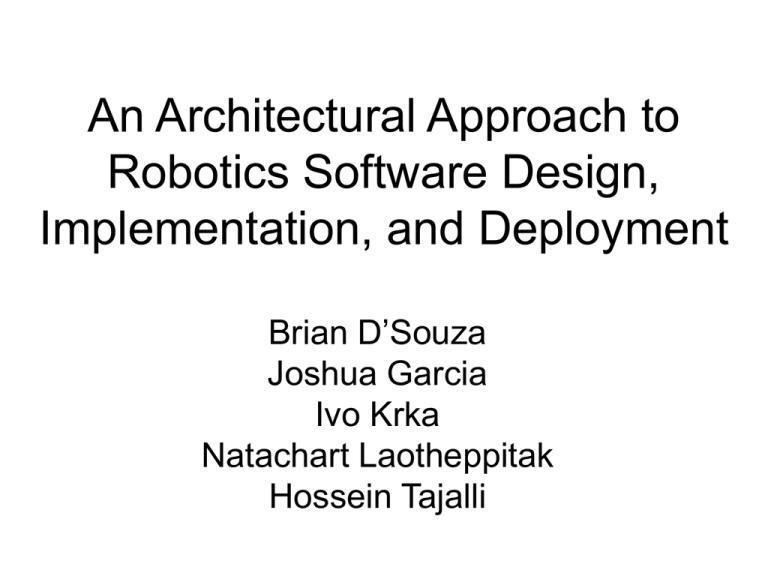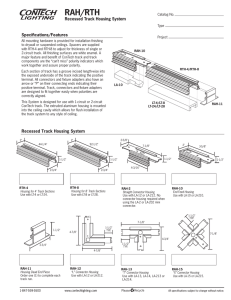An Architectural Approach to Robotics Software Design, Implementation, and Deployment Brian D’Souza
advertisement

An Architectural Approach to Robotics Software Design, Implementation, and Deployment Brian D’Souza Joshua Garcia Ivo Krka Natachart Laotheppitak Hossein Tajalli Outline • • • • • • • • • Motivation Initial Stage Suggested Architecture Manager Primary Connector Component Example Admin Conclusion Motivation • Provide a more disciplined approach to building embedded systems – Applying software architectural principles to robotics systems • Merging of heterogeneous types of applications in an embedded systems environment • Abstract away lower-level software development details Design using software architectural abstractions and implement using architectural middleware Prism-MW Motivation • Desirable properties – Distribution – Mobility – Scalability – Maintainability – Evolvability – Concurrency Initial Stage – Course Project • 589 – Software Engineering for Embedded Systems taught by Prof. Nenad Medvidovic • Video: http://video.google.com/videoplay?docid=1355003473678326666&q=cs589&total=5&start=0&num=10&so=0& type=search&plindex=1 Next stage • Class project showed that students with very limited robotics experience were able to create a new interesting application • Current objectives – Creating a more general and adaptable architecture – Variety of possible new applications Suggested Architecture Admin Physical Device Component 1 Component 2 Primary Connector Component n Deployment System Manager Manager • Parameters – List of Machine Interfaces (e.g. iRobot, Display, User Input Device, Motion Sensor, Temperature Sensor, camera ,etc.) – List of Components • Discovers other hosts around and communicate with them • Host Rendezvous • Request Admin to download new components from other hosts • Decides whether to connect one of its components to peer components in other entities • Decides to start and stop components (Planning) Primary Connector • Communicating the events between components in the same physical entity or between different entities • Routing, filtering, broadcasting the packages to desired sockets • Connector types may vary Component • Components can use device drivers to communicate with the physical devices – E.g., for a sensor, a component can read the sensor values – E.g., for a robot, one component can control the robot to follow a line, turn a corner, etc. • Cooperation with local and remote components – E.g., they can share positions of discovered obstacles • Components carry information about their supported interfaces and services Example Admin Admin Line Follower Admin Connector User Interface Connector Connector Wall Follower Manager Manager Manager Admin • Supports dynamic adaptation and component mobility • Ability to (re)deploy components onto a different host – Specify connector to attach component to – Dependent files – Requester or replier Admin Manager Admin Connector Component Connector redeploy AdminUI redeploy redeploy Connector Admin Byte Array Component Conclusion • Non-functional qualities of robotics applications need to be better addressed • Raising the level of abstraction of robotics systems development • Encouraging initial results of application of our architectural approach • Future work on realizing details of the approach and introducing new facilities

